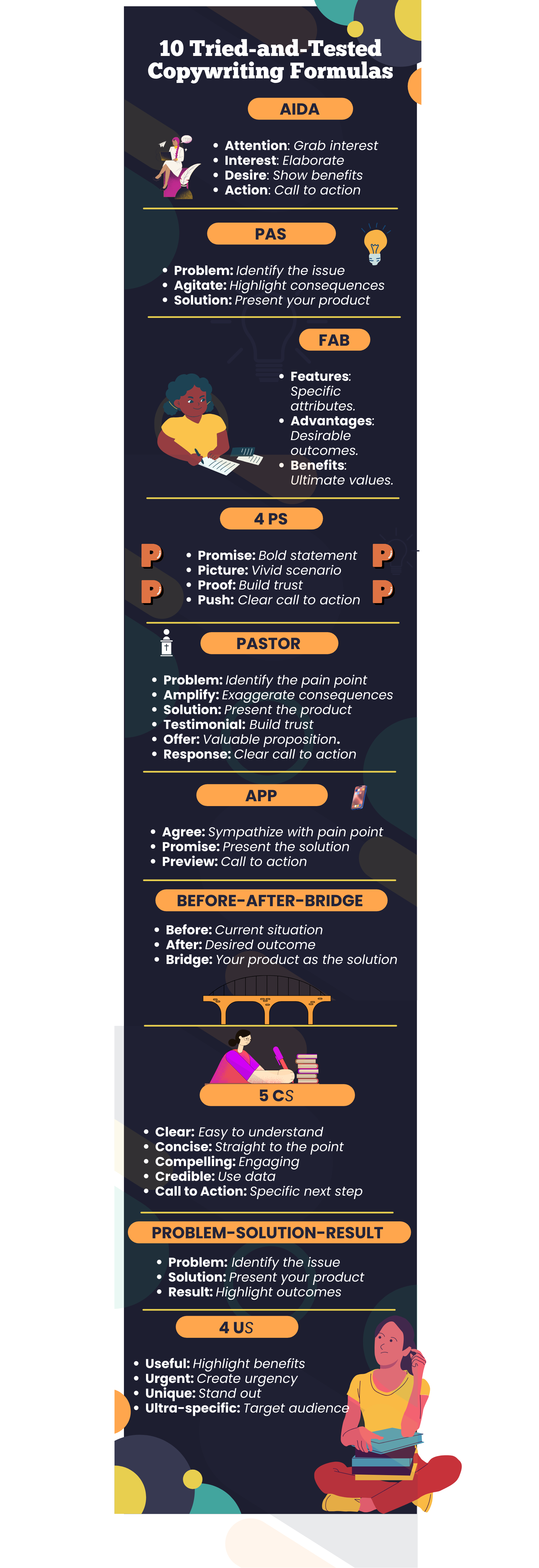
Are you aiming for a success story in your marketing efforts?
A lot of businesses know the struggle of crafting a marketing strategy that really delivers an impactful message. For this, you only want one question to be answered – how can you persuade the readers from start to finish? Fortunately, people have been writing for ages.
This article will tackle tried-and-tested copywriting formulas that will upgrade your persuasion skills.
By familiarizing yourself with the most popular copywriting formulas, you’ll be ready to attract an audience and drive engagement with confidence and ease.
The Top 10 Best Copywriting Formulas
Copywriting is a form of content writing aimed to persuade readers to take action. The writing process involves research and planning, careful crafting of the message, and diligent editing. The ultimate purpose is to create content that resonates with the audience and drives desired actions – through social media, a sales page, a blog post, or whatever other channel you might use.
Crafting a compelling copy is a must-be in marketing and advertising, especially for small business owners in the Philippines. It serves as the bridge between you and your customers. Being able to boost sales by persuading people to buy is a skill any business owner hopes to hone.
To help you hone yours, we will explain 10 simplified copywriting formulas for you to start getting into. Let’s get right into it.

AIDA: Attention, Interest, Desire, Action
Turn fleeting visitors into loyal buyers using the AIDA approach. It is a classic copywriting formula that means Attention, Interest, Desire, and Action. It’s also similar to another well-known structure, the ACCA (or awareness, comprehension, conviction, and action).
AIDA means the following:
- Attention. Grab the reader’s attention and interest with a compelling headline. It can be with a thought-provoking question, a surprising statistic, or a relatable anecdote.
- Interest. After grabbing their attention, elaborate on the problem or the opportunity you just presented to pique their interest.
- Desire. It’s now time to make your reader desire your product or service. Make them desire your product by showcasing the benefits they can gain or how it can improve their lives.
- Action. Your ending statement should be a call to action. Tell your readers precisely what to do next, may it be visiting your website or making a purchase.
This can be applied in a lot of various marketing scenarios. Whether in long-form sales pages, landing pages, or presentations, the AIDA formula can help you effectively communicate your message and drive action from your Filipino audience.
Implementing this formula can increase the likelihood of engagement and conversions. It is best if you do it effectively as it can only waste your resources and miss opportunities if done wrong.
PAS: Problem, Agitate, Solution
This copywriting formula particularly focuses on the pain points of the audience and convinces them to take action. This is quite effective in lead-generation campaigns, product launches, and content marketing.
The PAS formula stands for the following:
- Problem. Focus on articulating the problem or pain point that your target audience is experiencing.
- Agitate. Highlight the consequences or implications of not solving it to agitate the problem. This step should intensify their desire for a solution that compels them to take action.
- Solution. This is when you present your product or service as the solution to the problem. Clearly explain how your offering can fulfill their needs. Highlight the benefits and unique features of your products or services and explain why it’s the best solution available.
Proving them right about your products will build credibility around your brand.
Just make sure what you’re claiming as the solution is tested and legitimate, because if customers feel they’ve been misled by your claims or feel they are wasting money, they may share their negative experiences with others. This can greatly harm your reputation and struggle to attract and retain customers.

FAB: Features, Advantages, Benefits
If you want to highlight the unique features of your product or service, the FAB formula is the go-to technique.
It comprises of the following:
- Features. Advertise the specific characteristics or attributes of your product or service including specifications, functionalities, or components.
- Advantages. Explain the desirable outcomes that they can have from the features you advertised. It should explain practical solutions for the customer.
- Benefits. What are the ultimate values that these features bring? You should be able to explain how it improves life, business, or situation.
Effectively delivering the unique features, advantages, and benefits of your offers in the Philippines can differentiate your brand from your competitors. It’s easy too – even simple bullet points will do, as long as it’s well-researched and relevant.
On the other hand, failing to effectively use these features may result in misalignment with the reader’s desire, needs, and expectations.
4 Ps: Promise, Picture, Proof, Push
This technique stands out for its emphasis on making bold statements to pique the interest of the target audience. It keeps the focus on the reader’s desires, not just the features of the product.
The 4Ps are composed of the following aspects:
- Promise. Grab the reader’s interest and create curiosity by stating a bold promise they can benefit from purchasing or setting an appointment.
- Picture. After that, paint a vivid picture or scenario of what they can get after you deliver on that promise. Another tip is to use storytelling, sensory details, and emotional language to better provide them with the positive transformation your product can bring.
- Proof. Use endorsement formulas, social proof, testimonials, or statistics to build trust and credibility.
- Push. Persuade readers with your call to action. Tell them exactly what to do next, like signing up for a free trial. It should be strong to create this sense of urgency to act.
One example of this formula in the Philippines context is Jollibee’s “Sarap ng Pasko” campaigns.
They have utilized the Christmas celebrations and highlighted the promise of joy and togetherness of Filipino gatherings centered around a delicious Jollibee feast. They were able to leverage their long-standing presence in the Filipino community as proof.
The call to action is also clear – to encourage people to make Jollibee part of their Christmas event, with limited-edition offers.
PASTOR: Problem, Amplify, Solution, Testimonial, Offer, Response
If your product or service requires more explanation to understand its value, the PASTOR formula is the one for you. It is both persuasive and builds trust with your audience.
The PASTOR acronym stands for the following:
- Problem. Identify the problem or pain point you want to focus on.
- Amplify. Exaggerate the problem or pain point and the potential consequences of not addressing it. This will create a sense of urgency.
- Solution. Introduce your product or service as the solution to this problem. Explain why and how it delivers benefits.
- Testimonial. Use testimonials from satisfied customers to build trust.
- Offer. Present a valuable offer. It can be a free trial, a discount, or a guarantee.
- Response. Tell them what to do next. Your call to action should be clear and easy to follow, like visiting your website or maybe contacting you for more information.
Like other copywriting formulas, this will also increase conversions if done right and enhance your credibility. Just make sure you don’t overly amplify the problems as it can backfire and make your reader feel discouraged, or give out an unclear or complicated call to action because it can confuse them.
APP: Agree, Promise, Preview
This great formula is used specifically to persuade users to consider or engage with your offer. If your business can use this, take note of the acronym APP.
It stands for:
- Agree. In introducing your product, identify a specific pain point that your offer can solve. “Agree” that it’s a problem and sympathize.
- Promise. Once you’ve highlighted that pain point, present yourself as the solution to this pain point. This stage focuses on convincing users to engage with your solution.
- Preview. This stage should be able to convert these users into paying customers with your call to action. This should “preview” the benefits that they will reap from the specific action such as installing the app or buying your product.
Just like how Facebook marketing is successful now, you can be successful with this formula and attract a lot of users. When you successfully communicate your product’s features and benefits, it can boost user satisfaction since their expectations will be met.
Otherwise, it may lead to negative reviews and ratings from dissatisfied users.

Before-After-Bridge
The BAB copywriting approach highlights the change to be experienced by the audience. It’s a powerful storytelling technique that can create a compelling marketing copy for your readers to take action.
BAB stands for:
- Before. Raise awareness of the current situation or problem being experienced by your audience.
- After. Then describe the desired outcome or solution that the audience desires.
- Bridge. Introduce your product or service as the bridge of these ‘before’ and ‘after’ scenarios. Highlight how your offer can achieve their goals.
This simple formula can capture the attention of your audience and inspire them to purchase your product or service to achieve their desired transformation. There are a variety of ways you can deliver this, from simple narratives to more complex how-to formula blogs.
However, poor execution of this technique won’t resonate with the emotions of the Filipino audience and will result in low engagement and interest in your offer.
5 Cs: Clear, Concise, Compelling, Credible, Call to Action
This technique is versatile and can be used in any marketing context. It stands out from other techniques due to its specific focus on five key elements: Clarity, Conciseness, Concreteness, Credibility, and Call to Action.
The 5 Cs formula is:
- Clear. Your message should be easy to understand and avoid jargon and complicated terminologies.
- Concise. Keep it straight to the point of your message, and without unnecessary words or phrases.
- Compelling. It should be engaging and interesting to keep your reader’s attention.
- Credible. Use statistics or any data to demonstrate the reliability of your claims.
- Call to action. Clearly state what you want them to do next.
Clear and concise communication ensures your ad copy is easily understood by your target audience. Combining logic, emotion, and a clear CTA, you can persuade readers to take the desired action.
Too much focus on clarity and conciseness might not make your message attention-grabbing. Balance is key.
Problem-Solution-Result
Another good copywriting formula is the problem-solution-result formula. Copywriters love this because of its simplicity and effectiveness. This is essentially good to use for product description writing, a landing page, Facebook advertising, video sales letter, and many more.
Here’s a breakdown of the three stages:
- Problem. Identify the problem or challenge your target audience is facing.
- Solution. Introduce your product as the answer to this problem. Explain why and what benefits can be gained from it. Focus on the value proposition.
- Result. Highlight the most desirable outcomes by using your solution. An example would be happier customers or anything that is a positive impact your product generates.
Other techniques might offer additional elements like building trust or grabbing attention, but PSR excels in its clear and concise communication style.
The 4 Us: Useful, Urgent, Unique, Ultra-specific
Last but not least, the 4 U’s is a helpful structure that is attention-grabbing, engaging, and actionable. It’s particularly effective for website headlines, email subject lines, social media posts, blog posts, ad copies, and many more.
The 4 Us mean:
- Useful. Highlight how useful your product or service is. Focus on the benefits, not just features.
- Urgent. Create scarcity action. This could be highlighting potential consequences or offering limited promos. Your choice.
- Unique. Make sure your message stands out from the crowd. Be creative and unique to differentiate yourself from other competitors.
- Ultra-specific. Target a very specific audience or problem. Use details that a clearly defined group will notice.
This headline formula can guide you to craft headlines and other content that will magnetize sales into your business. Unsuccessful attempts in implementing this technique can have a detrimental impact on your marketing efforts like wasted resources and missed opportunities.

Final Thoughts
The struggle to create a compelling copy is a common challenge faced by many marketing teams. However, with the insights and actionable tips shared in this article, you are now ready to overcome this challenge with ease.
Throughout this article, we’ve tackled each formula in detail, offering practical tips to guide you in applying them effectively to your own marketing efforts. From the AIDA technique to the PAS formula and beyond, each formula offers a unique approach to capturing attention and driving action.
Now, it’s time to choose the best copywriting formula based on your specific goals, target audience, and the message you want to convey. What formula do you think would benefit you the most?
Frequently Asked Questions
What is the STAR story solution?
STAR story solution is another formula in copywriting that stands for Situation, Task, Action, and Result. It helps make your marketing messages more relatable and persuasive by presenting real-life examples of how your offering can address specific needs.
What are the stages of persuading an audience through copywriting?
The stages include awareness, comprehension, and conviction. These stages are often referred to as the AIDA formula, which stands for Attention, Interest, Desire, and Action. AIDA is a classic example of a copywriting formula that is still effective up to this day.
Why should I use copywriting formulas?
Copywriting formulas are an effective method for creating messages that attract attention, communicate value, and persuade the audience to take action. This provides a framework that guides your readers through a crucial decision-making process.